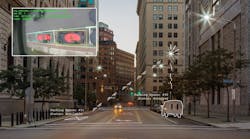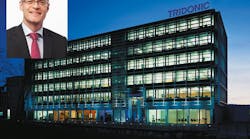Meanwhile, the lights of parent company Royal Philips Electronics will soon illuminate the new Octavio Frias De Oliveira Road Bridge, São Paulo, Brazil, on a full-time basis.
At the Alamo, the temporary installation marked the first time the Alamo, an important symbol of Texas liberty and American history, was illuminated on a grand scale, demonstrating the ease with which LED lighting can transform venues for special occasions. The structure served as the backdrop for a visually striking light installation held in conjunction with Luminaria, a one-day celebration of San Antonio's diverse artistic community.
The lighting design was conceived by Bill FitzGibbons of Blue Star Contemporary Art Center using Philips ColorBlast 12 fixtures, which combine LED sources with digital control technology to produce near-endless color combinations. FitzGibbons refers to these art installations as "architectural interventions," emphasizing the dynamic effects that are made possible with ColorBlast 12 fixtures.
"My concept was to provide onlookers with a new perspective of the Alamo, while using light and color in a creative way to reflect the spirit of our local arts community," said FitzGibbons.
The Alamo is typically lit by incandescent PAR lights, which would have required colored gels or filters to produce colored lighting effects. For Luminaria, FitzGibbons temporarily installed the ColorBlast 12 fixtures along the ground facing the Alamo's facade, painting it with deep, saturated colors. The light show was synchronized to the music of the San Antonio Symphony, first washing the façade in steady white light then bright greens, yellows and blues that tracked across the structure. Only 30 fixtures were required to illuminate the entire surface from the ground up.
Octavio Frias de Oliveira bridge
Meanwhile, Royal Philips Electronics’ additions to the Octavio Frias de Oliveira bridge in Sao Paulo, Brazil, were previewed on April 24th. The bridge will be lit permanently this month on the highway complex’s inauguration day using the company’s newest lighting technologies including LED. The bridge was built over the Pinheiros River beltway to link the districts of Brooklin and Real Parque. The solutions provided by Philips consume 53% less energy than traditional lighting systems, while reducing maintenance costs and improving road safety.
The exterior of the tower and the suspension cables attached to it will be lit by a delicate white light provided by ArenaVision projectors, which have been developed to light the world’s foremost sporting arenas such as the stadiums used in the World Cup Soccer competitions. The lighting solution for the exceptional Octavio Frias de Oliveira bridge has been developed by lighting designer Plínio Godoy, together with the architect responsible for the project, Joao Valente and (a bridge building company) OAS builder.
The lighting project also put clear focus on the safety of the motorists who will be driving across the bridge. With them in mind, the lanes and slip-roads will be lit by a Cosmopolis system of 140W white-light bulbs, which contributes to overall safety on the road. It also allows the light to be directed solely onto the road surface, thus avoiding leakage of light onto the tower or the cables. Ground projectors are to be inlaid in the earth of the gardens which are being built underneath the bridge, providing an interesting effect for the area’s plant life.
The ColorBlast projectors used are amongst the most efficient lighting systems on the market. They consume only 10% of the energy used by a traditional projector. A single electric shower uses the same amount of energy as 90 ColorBlast projectors. The Cosmopolis system installed in the Casa Forte town square in the city of Recife has enabled the Pernambucocapital’s city government to spend around 58% less on electrical energy in the area’s lighting.




![An installer uses a cell phone to configure a connected lighting system in a Next Generation Lighting Systems (NGLS) living lab. [Photo credit: Image courtesy of Pacific Northwest National Laboratory (PNNL) and NGLS.] An installer uses a cell phone to configure a connected lighting system in a Next Generation Lighting Systems (NGLS) living lab. [Photo credit: Image courtesy of Pacific Northwest National Laboratory (PNNL) and NGLS.]](https://img.ledsmagazine.com/files/base/ebm/leds/image/2020/06/NGLS_Photo_2.5ed693de53fa2.png?auto=format,compress&fit=crop&q=45&h=139&height=139&w=250&width=250)


